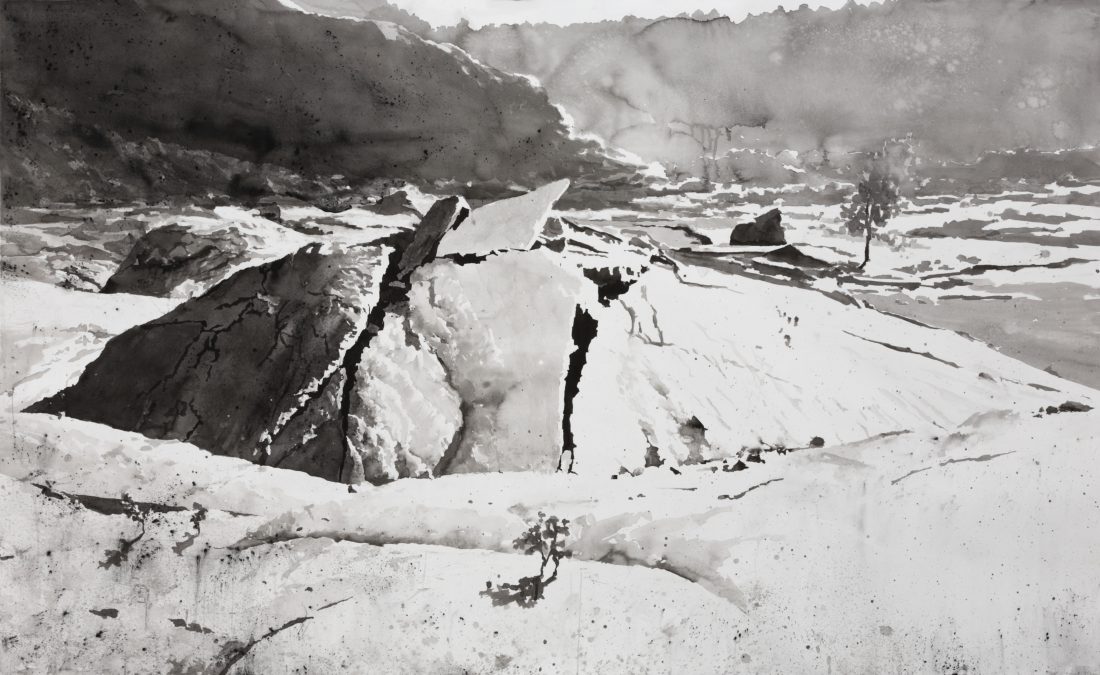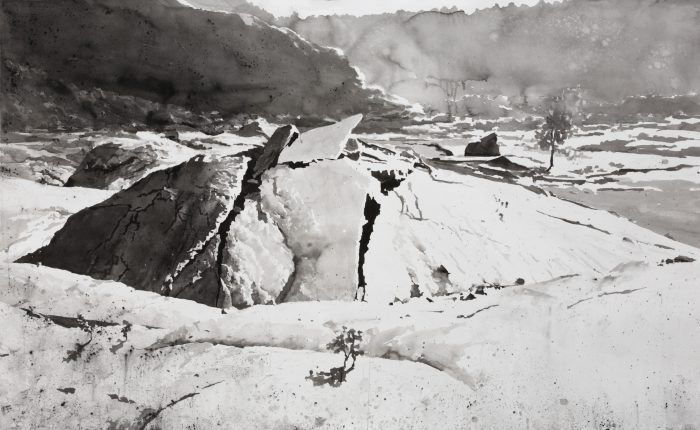Emma Stibbon
Available Works
Painter and Printmaker Emma Stibbon was born in 1962 in Münster, Germany. She studied at Portsmouth College of Art, then at Goldsmith College in London and was finally awarded her Master’s degree from the University of the West of England in 2005. Internationally renowned for her award-winning art, she has travelled extensively: her work explores the impact of both natural and human-generated changes on some of the worlds most isolated regions.
Working from photographic sketches and records, Emma’s work is romantic in character: her large, monochrome prints are concerned with the relationship between art and the environment. Committed to acting as witness to these diverse, rapidly changing places, Emma often couples art and science: she ensures the accuracy of her work by working closely with geologists and scientists, and by conducting location-based research.
The duality of Emma’s oeuvre, which captures the beauty of nature whilst highlighting the urgency of the situation that we find ourselves in, was recognised when, in 2013, Emma was elected as Royal Academician.
Emma has established her reputation through a series of residencies, including: a Derek Hill Scholarship at the British School in Rome (2010), the Friends of Scott Polar Research Institute placement in Antarctica (2013) and the Arctic Circle (2013), the Hawai’i Volcanoes National Park Residency (2016); the Josef and Anni Albers Foundation, Connecticut (2016); Project Pressure, Annapurna Range, Nepal (2017); National Parks North Rim Residency, Grand Canyon (2017). More recently, Emma was commissioned by York Art Gallery and Lakeland Arts to visit Chamonix in the French Alps for Storm Cloud, a project in which she photographed and painted the glaciers around Mont Blanc (2019).
Additionally, over the years Emma has received numerous prizes for her work: the Lark Trust Prize, RWA Open Triennial (2000), the Dupree Prize for Woman Artist, the Royal Academy Summer Exhibition Nominated her for the Paul Hamlyn Foundation Award (2001), the Research Fine Art Award, the Rootstein Hopkins Foundation, St Cuthberts Mill Paper Prize, the RWA Autumn Open, the Talboys Bequest Purchase Prize (2002), the T N Lawrence Prize, RWA Open Print Exhibition (2004), the Artist Award: Arts Council England, South West (2005), the Printmaking Today Prize: Originals, Mall Galleries (2006), the Faculty Research Award, University of Brighton School of Arts, Design and Media Artist Award: Arts Council England, South West (2007), the Newcastle on Tyne Artist Award: Arts Council England, South West (2009), the Friends of the Laing Purchase Prize (2010), The Arctic Circle; Svalbard Expedition Grants for the Arts Award (2013), Honorary Doctor of Letters, University of Bristol (2018), and the Queen Sonja Print Award, Arctica, Svalbard (2019).
Since 2008, Emma has been teaching at the University of Brighton. Now a Senior Lecturer in Fine Art Printmaking, Emma works from her studio at Spike Island and Spike Print Studio in Bristol.
She has been selected to join a second expedition to Svalbard in October 2021 by The Arctic Circle: during the residency, Emma plans to draw glaciers and ice sheets that are melting as part of her ongoing interest in documenting changing and threatened environments.
She is also part of the Selection and Hanging Committee 2021 for the Royal Academy of Arts, London Summer Exhibition, where she will be curating the print galleries.
Stibbon’s work is part of numerous collections, such as the Bristol City Museum and Art Gallery; the Dorset County Hospital; the Fitzwilliam Museum in Cambridge; the Jonathan Meese Collection in Kolm; Laing Art Gallery in Newcastle on Tyne; Pallant House Gallery, Chichester; the Potsdam Museum in Berlin; the New Art Gallery in Walsall; the New Hall Art Collection in Cambridge (housed in Murray Edwards College); the Russell-Cotes Art Gallery and Museum in Bournemouth; the Scott Polar Research Institute (University of Cambridge); the Stadtmuseum in Berlin; the Victoria & Albert Museum in London, and in Arctica in Svalbard.

